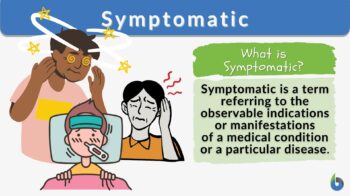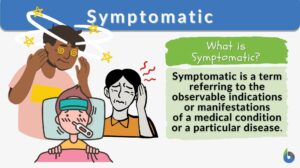
Symptomatic
adj., [/sɪmptəˈmætɪk/]
Definition: Relating to or characterized by recognizable signs or symptoms of a disease or condition
Table of Contents
Symptomatic Definition
Symptomatic is a term that pertains to the observable manifestations or particular conditions indicative of a medical condition or a particular disease. The term may be commonly associated with medicine and pathology but the term also extends to any discernible signs of a state of a phenomenon. Similar to medicine, though, the term “symptomatic” in biology refers to the manifestation of observable signs or symptoms. An example of the usage is “symptomatic treatment”, also known as palliative or supportive care that aims to alleviate the symptoms of a medical condition. This form of treatment though is focused on managing the symptoms and not directly addressing the underlying cause. Examples of such a type of treatment are pain management, anti-inflammatory medications, antiemetics, fever reducers, physical therapy, and nutritional support.
Etymology: The term “symptomatic” originates from the Greek words “symptōmatikos,” meaning indicative or symptomatic, derived from “symptōma,” which means a symptom or occurrence.
Compare: asymptomatic
See also: disease
Symptomatic vs Asymptomatic Patients (by Newman Regional Health):
What Is A Symptom?
As the term symptomatic revolves around the concept of symptom, let us define a symptom.
A symptom refers to any observable indications or manifestations of a medical condition, disease, or disorder. It is essential in the diagnostic process as the patient reports to a medical specialist, to determine the condition.
Symptoms and signs are two distinctive terms in medicine although they may appear to be the same. Signs are measurable and observable indicators of a condition that are detected by healthcare professionals, such as during a clinical examination, laboratory test, or other diagnostic procedures. Symptoms are subjective in a way that the individual feels or experiences and reports to a healthcare provider.
Examples of symptoms are pain, fatigue, nausea, dizziness, and headache as opposed to signs such as elevated blood pressure, a skin rash, high blood glucose levels, and abnormal heart sounds.
Symptoms may be classified into physical, behavioral, and physiological. Below is the symptomatic classification:
- Physical symptoms: examples are pain, fever, swelling, abnormalities in vital signs, and changes in skin color or texture
- Behavioral symptoms: examples are mood, sleep disturbances, cognitive impairments, and shifts in appetite, encompassing changes in the individual’s cognitive and emotional processes
- Physiological symptoms: changes in the physiology, which are associated with changes in biochemical pathways, genetic expressions, or cellular functions.
Examples In Biology
In the realm of biology, the term symptomatic is often associated with the following:
- Symptomatic patients, i.e., individuals exhibiting observable signs or showing symptoms of a medical condition (as opposed to asymptomatic patients)
- Symptomatic analysis, i.e., examination and interpretation of observable symptoms and signs to determine, for example, the severity of the disease or medical condition
- Symptomatic relief, similar to symptomatic treatment, symptomatic relief targets the symptoms of a disease, providing relief but not necessarily curing the condition
- Symptomatic markers, i.e., molecular markers that characterize certain diseases
NOTE IT!
Complexity of Symptoms and Diagnostic Significance
An interesting note about symptomatic conditions is the variation of symptoms among individuals with the same medical condition. Possible factors that contribute to this variability are genetic predisposition, overall health, and environmental influences. Thus, the intricacy of symptoms is alleviated with the advancement of diagnostic technology and tests, facilitating a more accurate and timely determination of the underlying cause, especially for individuals without clear symptoms, such as in the case of asymptomatic individuals who may be unaware of the presence of the disease or infections. Thus, sick individuals who do not show discernible symptoms have a higher tendency to spread the disease. Understanding whether an individual is symptomatic or asymptomatic is crucial to effective disease management and public health efforts.
References
- Sign or Symptom (Concept Id: C3540840) – MedGen – NCBI. (2022). Nih.gov. https://www.ncbi.nlm.nih.gov/medgen/761917
©BiologyOnline.com. Content provided and moderated by Biology Online Editors.







